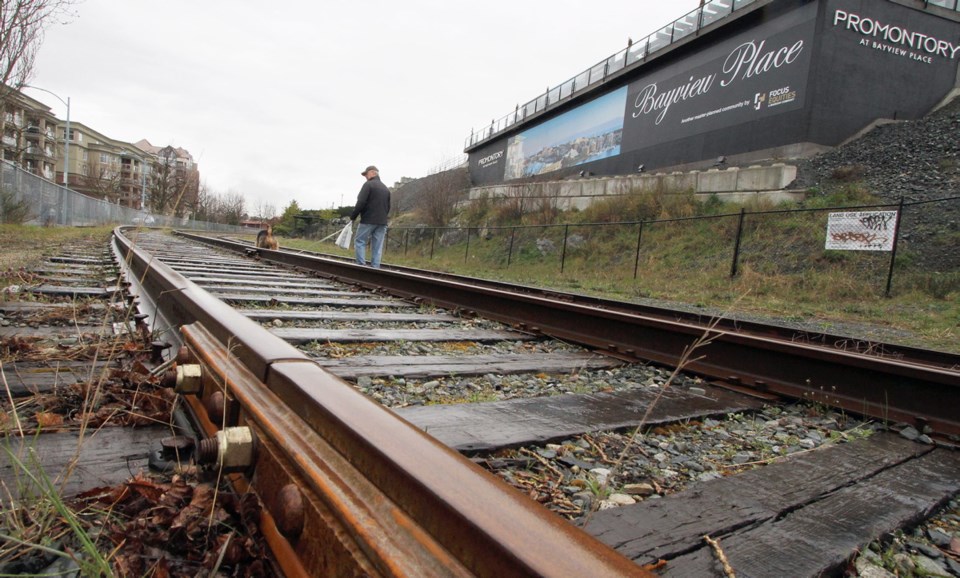The Island Corridor Foundation’s chief executive is advocating for a “hybrid” Vancouver Island rail system he estimates would cost $300 million — hundreds of millions below estimates in a recent report.
There’s no need to spend up to $729 million, plus another $595 million for a Langford-Victoria commuter rail service, as outlined by a consultant, Larry Stevenson said Tuesday.
Consultant WSP developed a condition report of the E&N rail line, describing various cost scenarios and phases to bring it back into service. The report went to the province, which is developing a transportation strategy for the south Island.
At the lower end, a first phase of rail service was pegged at $326 million in the report, with an intermediate phase at $552 million. Those figures do not include the commuter service.
Stevenson believes the system could be brought back for less, and that investment would be useful for the future as demand increased.
“This is not a discussion about today, really. This is a discussion about what we want to have on this Island 20, 30 and 40 years from now,” he said.
“The Island is growing and it is going to continue to grow. Here you have an arterial vein that runs right down the Island and through the major population centres. It is going to be required.”
The corridor runs 225 kilometres from Victoria to Courtenay, with a 64-kilometre leg to Port Alberni. Passenger service was shutdown in 2011 over worries about track condition.
The foundation owns the corridor. Its board includes representives of regional districts and First Nations on the Island.
Stevenson suggests that an intermediate-level rail system would be the most suitable. It would have higher rail speed of 50 kilometres an hour, compared with 30 kilometres per hour suggested for the first phase. It would carry passengers and could offer excursions and tourist trains, as well as freight service.
He figures that the $552-million estimate for the intermediate system could be shaved to $215 million, with a contingency buffer moving it up to about $300 million for the entire system. It would incorporate the Langford-Victoria commuter service, meaning the $595 million spending estimate would not be needed.
Stevenson would like the province to call a meeting that includes the foundation, B.C.’s Transportation Ministry and other stakeholders to discuss what might be possible.
He fears that unless a plan is developed, the opportunity for rail service will be lost.
Stevenson points to Waterloo, Ont., which spent $800 million on a 19-kilometre rail system. “Since they started that process, housing, building around the corridor, has amounted to $3.2 billion, so they are getting a huge return on investment. And that’s the kind of thing that will happen here as well,” he said.
Stevenson said he supports the construction estimates of the consultant, who fulfilled the mandate from the province.
He believes that costs could be reduced by close to $120 million by cutting back on the proposed the freight capacity.
Higher freight capacity would be useful for the section of the line running to Port Alberni, Stevenson said, but that level isn’t needed on the rest of the system. “I personally believe there is a pot of gold at the end of the rainbow in Port Alberni. That is freight traffic that can come in and out of that port,” he said.
Increased use of Port Alberni’s deep-water port could alleviate congestion of large container ships lining up to get to Vancouver, he said.
Rail cars could be loaded in Port Alberni, taken along the line to a rail ferry in Nanaimo to be carried to the mainland to link up with the major railways serving North America, he said.
Stevenson has ideas on how to decrease costs. He suggests rather than a $60-million maintenance facility, as in the report, a $2-million facility using a Quonset hut could be set up on existing railyard land in Nanaimo.
The number of trains, the type of cars, and the frequency of trips outlined in the report could be cut back as well, he said.
Trains described in the report are high-end and high-tech, he said. Lower-cost trains could be used.
Fewer trains could run, going at peak travel times only, with perhaps one offered mid-day, he said.



